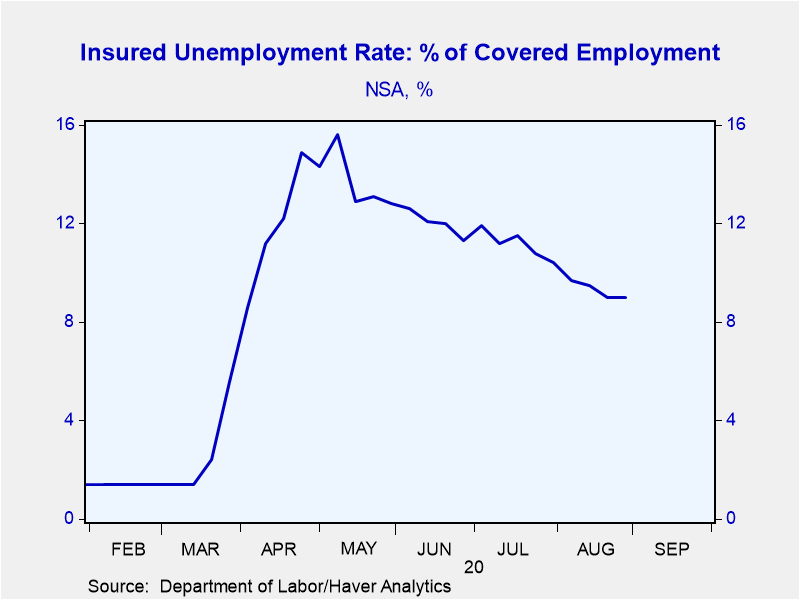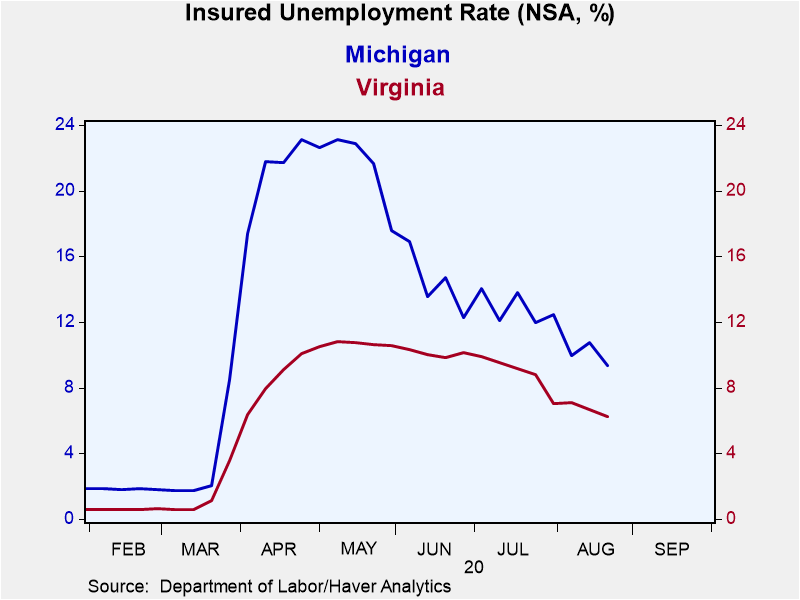 Global| Sep 10 2020
Global| Sep 10 2020U.S. Jobless Claims Flat to Up
Summary
• Seasonally adjusted state initial claims unchanged at 884,000 in the week ending September 5. • Not seasonally adjusted state initial jobless claims rise to 857,148. • Federal Pandemic Unemployment Assistance new filers increased to [...]
• Seasonally adjusted state initial claims unchanged at 884,000 in the week ending September 5.
• Not seasonally adjusted state initial jobless claims rise to 857,148.
• Federal Pandemic Unemployment Assistance new filers increased to 838,916, the fourth consecutive gain.
• PUA continuing claims at 14.6 million surpass regular/state claims of 13.2 million.
Seasonally adjusted state initial jobless claims for unemployment insurance were unchanged at 884,000 in the week ending September 5. A change in the calculation of seasonal adjustment factors created a break in the series two weeks ago; though the current week-to-week comparison is valid. For more details, please see last week's commentary on jobless claims.
The not seasonally adjusted data, which is comparable across all periods for initial claims rose to 857,148 in the week ending September 5 from 837,008. Haver Analytics has calculated methodologically consistent seasonally adjusted data. This shows claims edging down to 886,000 from 887,000. As this data illustrates, our calculated seasonal adjustment factors closely match the Department of Labor (DoL seasonals. However, there are some gaps between the seasonal adjustment factors released by the DoL for the remainder of the year and our estimated factors.
Claims for the federal Pandemic Unemployment Assistance (PUA) program, which covers individuals such as the self-employed who are not qualified for regular/state unemployment insurance, increased for the fourth consecutive week to 838,916 from 747,913. PUA claims are up roughly 350,000 since their near-term low on August 8. Numbers for this and other federal programs are not seasonally adjusted.
Seasonally adjusted state continuing claims for unemployment insurance increased to 13.385 million in the week ending August 29, from 13.291 million. This week-to-week comparison uses the same seasonal adjustment methodology. Not seasonally adjusted continuing claims rose to 13.197 from 13.143 million. Haver Analytics methodologically consistent seasonally adjusted continuing claims grew to 13.387 million from 13.274 million.
Continuing PUA claims, which are lagged an additional week and not seasonally adjusted, jumped to 14.592 million from 13.570 million. In the last two weeks they have risen 3.6 million and now surpass regular/state continuing claims. Pandemic Emergency Unemployment Compensation claims continued their upward climb to 1.422 million in the week ending August 22. This program covers people who were unemployed before COVID but exhausted their state benefits and are now eligible to receive an additional 13 weeks of unemployment insurance, up to a total of 39 weeks.
The seasonally adjusted state insured rate of unemployment edged up to 9.2% in the week ending August 29. The not-seasonally-adjusted data was unchanged at 9.0%. This data does not include the federal pandemic assistance programs. If you include the latest data available, which is lagged one additional week, the number of continuing claims rose to 29.1 million -- the highest since early August -- or 18.2% of the labor force.
The state insured rates of unemployment -- which do not include federal programs -- continued to show wide variation with Idaho at just 1.9% and Hawaii at 20.3%. Ten states had rates above 10%, with Hawaii the only state above 20%. The largest states ranged between 5.2% for Florida and 14.9% for New York. The state rates are not seasonally adjusted.
Data on weekly unemployment claims going back to 1967 are contained in Haver's WEEKLY database, and they are summarized monthly in USECON. Data for individual states are in REGIONW. The expectations figure is from the Action Economics Forecast Survey, carried in the AS1REPNA database.
| Unemployment Insurance (SA, 000s) | 09/05/20 | 08/29/20 | 08/22/20 | Y/Y % | 2019 | 2018 | 2017 |
|---|---|---|---|---|---|---|---|
| Initial Claims | 884 | 884 | 1,011 | 325 | 218 | 221 | 244 |
| Initial Claims (NSA) | 857 | 837 | 826 | 435 | 218 | 221 | 243 |
| Initial Claims Pandemic Unemployment Assistance (NSA) | 839 | 748 | 608 | -- | -- | -- | -- |
| Continuing Claims | -- | 13,385 | 13,292 | 695 | 1,701 | 1,756 | 1,961 |
| Continuing Claims (NSA) | -- | 13,197 | 13,143 | 794 | 1,704 | 1,763 | 1,964 |
| Continuing Claims Pandemic Unemployment Assistance (NSA) | -- | -- | 14,592 | -- | -- | -- | -- |
| Insured Unemployment Rate (%) | -- | 9.2 | 9.1 |
1.2 |
1.2 | 1.2 | 1.4 |
Gerald D. Cohen
AuthorMore in Author Profile »Gerald Cohen provides strategic vision and leadership of the translational economic research and policy initiatives at the Kenan Institute of Private Enterprise.
He has worked in both the public and private sectors focusing on the intersection between financial markets and economic fundamentals. He was a Senior Economist at Haver Analytics from January 2019 to February 2021. During the Obama Administration Gerald was Deputy Assistant Secretary for Macroeconomic Analysis at the U.S. Department of Treasury where he helped formulate and evaluate the impact of policy proposals on the U.S. economy. Prior to Treasury, he co-managed a global macro fund at Ziff Brothers Investments.
Gerald holds a bachelor’s of science from the Massachusetts Institute of Technology and a Ph.D. in Economics from Harvard University and is a contributing author to 30-Second Money as well as a co-author of Political Cycles and the Macroeconomy.









